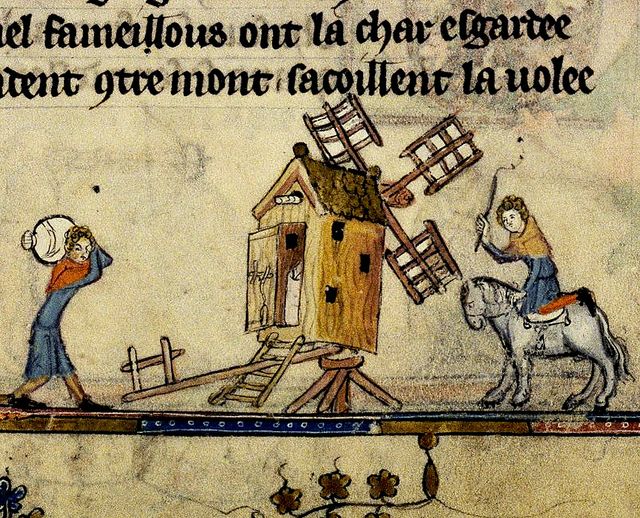 Lincolnshire is known for its windmills, they form an important part of the county’s unique historic landscape. The painter Karl Wood made many sketches and paintings of Lincolnshire’s windmills and a larger number of these are now held in The Collection in Lincoln. But what was Lincolnshire’s first windmill like?
Lincolnshire is known for its windmills, they form an important part of the county’s unique historic landscape. The painter Karl Wood made many sketches and paintings of Lincolnshire’s windmills and a larger number of these are now held in The Collection in Lincoln. But what was Lincolnshire’s first windmill like?
The grinding of grain has been a significant part of this nation’s life since the beginning of the New Stone Age or Neolithic period beginning around 4000 BC, although it is likely that the grinding or pounding of seeds for food had been going on before that. For most of the time since then, the majority of grinding was done by hand. This was done in two ways. The first was to have a large flattish stone on which the grain was placed (known as the saddle) and then a smaller rounded stone would be used to rub back and forth across the saddle to grind the grain. The other method was to have two circular stones with the upper set to rotate on the lower. These are known as rotary querns and are the predecessor of the more modern millstone.
Hand milling, quite literally the daily grind, was hard work, and so civilisations like the Romans were quick to use slaves or animals to do the physical work so that ordinary citizen could go about other business. However, although the process could be scaled up, the speed of production was not significantly greater and there was still a cost in feeding slaves and animals. At some point in the Roman period mechanical power, in the form of the vertical waterwheel, was applied to driving quern stones and the first watermills were created. However, their application would have been limited to locations that had a suitable source of running water, and so far few have been found in Britain and none (as yet) in Lincolnshire.
It is notable that there is no discernible link between Roman watermills and Saxon watermills. Indeed, the Roman mills used vertical wheels (similar to those occasionally seen today) that used gears to turn the rotation ninety degrees to rotate the millstones, whereas the Saxons used horizontal wheels that drove the millstones directly through a single wooden shaft. These horizontal mills continued through the early medieval period but were ultimately replaced by vertical wheels.
The first windmills in Europe were horizontal windmills that arrived in southern Europe in the 11th century, although they do not appear to have been widely adopted. The first recorded vertical windmills are found in Eastern England and the low countries, essentially large flat areas with little fast-flowing water. The first mills were post mills, small in size and had four sails that used linen sheets to catch the wind. To face them into the wind, the body of the mill was turned with a tail like a lever. Wind may have turned the wheels, but physical strength would still have been a requisite of the miller. The shape and layout of medieval mills are illustrated in a number of manuscripts including the 14th century Luttrell Psalter, which has strong associations with Lincolnshire.
However, there is somewhere you can look for yourself to see images of the first windmills in Lincolnshire. Church graffiti is a valuable source of information about the medieval later periods. Within it you will see contemporary images of people and objects, not drawn by monks (who are removed from the world) but by everyday people who worked with them. In Lincolnshire there are a number of simple line drawings of windmills. One well-known example is at Haceby, but while the Layers of History team was working with volunteers in Aslackby, we also came across an example there.
It is possible that there are others, hidden away and unrecorded in the hundreds of medieval churches in Lincolnshire. So why not have a closer look at your local church, and who knows; you might end up looking at Lincolnshire’s first windmill.
